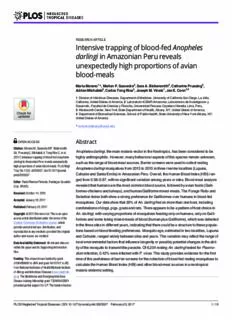Table Of ContentRESEARCHARTICLE
Intensive trapping of blood-fed Anopheles
darlingi in Amazonian Peru reveals
unexpectedly high proportions of avian
blood-meals
MartaMoreno1*,MarlonP.Saavedra2,SaraA.Bickersmith3,CatharinePrussing4,
AdrianMichalski3,CarlosTongRios2,JosephM.Vinetz1,JanE.Conn3,4
a1111111111 1 DivisionofInfectiousDiseases,DepartmentofMedicine,UniversityofCaliforniaSanDiego,LaJolla,
California,UnitedStatesofAmerica,2 LaboratorioICEMR-Amazonia,LaboratoriosdeInvestigaciony
a1111111111
Desarrollo,FacultaddeCienciasyFilosofia,UniversidadPeruanaCayetanoHeredia,Lima,Peru,
a1111111111
3 WadsworthCenter,NewYorkStateDepartmentofHealth,Albany,NY,UnitedStatesofAmerica,
a1111111111
4 DepartmentofBiomedicalSciences,SchoolofPublicHealth,StateUniversityofNewYork-Albany,NY,
a1111111111 UnitedStatesofAmerica
*mmorenoleirana@ucsd.edu
Abstract
OPENACCESS
Citation:MorenoM,SaavedraMP,Bickersmith
Anophelesdarlingi,themainmalariavectorintheNeotropics,hasbeenconsideredtobe
SA,PrussingC,MichalskiA,TongRiosC,etal.
(2017)Intensivetrappingofblood-fedAnopheles highlyanthropophilic.However,manybehavioralaspectsofthisspeciesremainunknown,
darlingiinAmazonianPerurevealsunexpectedly suchastherangeofblood-mealsources.Barrierscreenswereusedtocollectresting
highproportionsofavianblood-meals.PLoSNegl
Anophelesdarlingimosquitoesfrom2013to2015inthreeriverinelocalities(Lupuna,
TropDis11(2):e0005337.doi:10.1371/journal.
CahuideandSantaEmilia)inAmazonianPeru.Overall,theHumanBloodIndex(HBI)ran-
pntd.0005337
gedfrom0.58–0.87,withnosignificantvariationamongyearsorsites.Blood-mealanalysis
Editor:PauloFilemonPimenta,Fundac¸aoOswaldo
revealedthathumansarethemostcommonbloodsource,followedbyavianhosts(Galli-
Cruz,BRAZIL
formes-chickensandturkeys),andhuman/Galliformemixed-meals.TheForageRatioand
Received:October14,2016
SelectionIndexbothshowastrongpreferenceforGalliformesoverhumansinblood-fed
Accepted:January18,2017
mosquitoes.Ourdatashowthat30%ofAn.darlingifedonmorethanonehost,including
Published:February23,2017 combinationsofdogs,pigs,goatsandrats.Thereappearstobeapatternofhostchoicein
Copyright:©2017Morenoetal.Thisisanopen An.darlingi,withvaryingproportionsofmosquitoesfeedingonlyonhumans,onlyonGalli-
accessarticledistributedunderthetermsofthe formesandsometakingmixed-mealsofblood(humanplusGalliforme),whichwasdetected
CreativeCommonsAttributionLicense,which
inthethreesitesindifferentyears,indicatingthattherecouldbeastructuretothesepopula-
permitsunrestricteduse,distribution,and
tionsbasedonblood-feedingpreferences.Mosquitoage,estimatedintwolocalities,Lupuna
reproductioninanymedium,providedtheoriginal
authorandsourcearecredited. andCahuide,rangedwidelybetweensitesandyears.Thisvariationmayreflecttherangeof
localenvironmentalfactorsthatinfluencelongevityorpossiblypotentialchangesintheabil-
DataAvailabilityStatement:Allrelevantdataare
withinthepaperanditsSupportingInformation ityofthemosquitototransmittheparasite.Of6,204restingAn.darlingitestedforPlasmo-
files. diuminfection,0.42%wereinfectedwithP.vivax.Thisstudyprovidesevidenceforthefirst
Funding:Thisresearchwasfundedbygrant timeoftheusefulnessofbarrierscreensforthecollectionofblood-fedrestingmosquitoesto
U19AI089681toJMVandgrantAI110112toJEC calculatetheHumanBloodIndex(HBI)andotherblood-mealsourcesinaneotropical
fromNationalInstitutesofHealth/NationalInstitute
malariaendemicsetting.
ofAllergyandInfectiousDiseases(www.niaid.nih.
gov).TheBiodefenseandEmergingInfectious
DiseasetrainingfellowshipgrantT32AI05532901
providedpartialsupportforCP.Thefundershadno
PLOSNeglectedTropicalDiseases|DOI:10.1371/journal.pntd.0005337 February23,2017 1/19
AnophelesdarlingihostpreferenceforavianbloodinAmazonianPeru
roleinstudydesign,datacollectionandanalysis,
decisiontopublish,orpreparationofthe
Authorsummary
manuscript.
CompetingInterests:Theauthorshavedeclared AnophelesdarlingiisthemajormalariavectorintheAmazon.Thisspecieshasbeencom-
thatnocompetinginterestsexist. monlydescribedashighlyanthropophilicthroughoutitsgeographicrange,althoughlittle
isknownaboutitsfeedingpreferences.Scantinformationisavailableregardingtheorigin
ofAn.darlingiblood-meals.Inthecontextofmalariaeliminationprograms,theHuman
BloodIndex(HBI)mayprovidecrucialinformationregardingmosquito-humancontact
relatedtotransmissiondynamics.Additionally,collectionofrestingAn.darlingiischal-
lenging,mainlybecausetherestingbehaviorofthisspecieshasnotbeenwellcharacter-
ized.Ourstudy,conductedfrom2013–2015inthreelocalitiesinLoretoDepartmentin
thePeruvianAmazon,showedforthefirsttimetheefficacyofthebarrierscreenmethod-
ologyforcollectingrecentlyblood-fedAn.darlingiinaneotropicalsettingforthepurpose
ofidentifyingthesourceoftheirblood-meals.OurdatashowthatAn.darlingifeedson
humans,Galliformes,dogs,pigsandgoats,andthat30%ofthemosquitoesfedonmore
thanonetypeofhost.Despitethisopportunisticfeedingbehavior,however,An.darlingi
isprimarilyanthropophilic.Wehypothesizethatmosquitopopulationstructureisassoci-
atedwithfeedingpreferences,whichmayaffectthepatternofmalariatransmissioninthe
area.
Introduction
TheHumanBloodIndex(HBI),formerlyknownastheanthropophilicindexorhumanblood
ratio,istheproportionofrecently-fedmosquitoes,usuallyvectorspeciesthathavetakena
humanblood-meal[1].Thisindexisaveryimportantcomponentoftheformulaeusedto
determinevectorialcapacityandvariesdependingonmosquitospecies,collectionareaand
seasonortimeofcollection[2].Fromanepidemiologicalstandpoint,itiscrucialtobeableto
accuratelyidentifymosquitoblood-mealsforstudiesoftransmissiondynamicsofviraland
parasiticpathogens[3].Forexample,inEquatorialGuinea,thecalculationofthisindexbefore
andafterindoorinterventionstoreducemalariadidnotdetectanymosquitobehavioraldif-
ferences,andresearchersconcludedthatcontrolstrategiesinthisregionwereineffective[4].
InCentralKenya,anthropophilydecreasedinAn.gambiaeaftertheintroductionoflonglast-
inginsecticidenets(LLINs)andzooprophylaxis[5].However,insouthernZambia,aftertwo
yearsofLLINintervention,themainvector,Anophelesarabiensis,remainedhighlyanthropo-
philic[6].InTanzaniatheHBIshowedachangeinthemainblood-sourceinAn.arabiensis
butnotinAn.funestusaftertheuseofspatialrepellentcoils[7].
Anotherindextoquantifyhostselectionpatternsistheincidenceofmultipleblood-meals
fromthesamehostspecies(cryptic)orfromtwoormoredifferenthostspecies(patent)[8].
Evidencethatmalarialmosquitoestakepartialblood-mealsfrommultiplehostsmaybeinter-
pretedasinterruptedblood-feedingsthatcouldincreasetheprobabilityofbothacquiringand
transmittingPlasmodium[9].Ontheotherhand,Burkotandcolleagues[10]contendthat
fewergametocyteswouldbeingestedpermeal,resultinginlowermosquitoinfectionrates.
Anophelesdarlingi,theprimaryregionalmalariavectorintheAmazonBasin,isanthropo-
philicintheIquitosregion[11],althoughbothhumanbitingrate(HBR)andentomological
inoculationrate(EIR)varywidely[12]dependingonthesetting[13–15].TheAn.darlingi
feedingsiteinthisregionisexophagicand/orendophagic,dependingonlocalcircumstances
(e.g.,vegetationcover,typeofhouse)andhostavailability[11,12,14,15].
In2015,LoretoDepartmentreported95%ofthetotalmalariacasesinPeru(59,349of
62,220total)withPlasmodiumvivaxasthemostprevalenthumanparasitefollowedbyP.
PLOSNeglectedTropicalDiseases|DOI:10.1371/journal.pntd.0005337 February23,2017 2/19
AnophelesdarlingihostpreferenceforavianbloodinAmazonianPeru
falciparum,with46,924and12,425cases,respectively[16].Parkerandcollaborators[13]dem-
onstratedthathighHBR,EIR,andinfectivityofAn.darlingiareasignatureofremoteriverine
malariahotspotsandhyperendemicityincertainareasofthePeruvianAmazon,upending
previousnotionsthattransmissionishypoendemicthroughouttheperi-Iquitosregion
[11,12].RecentstudiesalsodetectedveryhighseasonalHBRandmoderateEIRintheperi-
Iquitosregion[14,15].Mostmalariacasesoccurduringtherainyseason,fromDecemberto
June[17]andacorrelationwasdetectedbetweenAn.darlingiabundanceandpeakriverlevels,
buttherewasnosignificantcorrelationbetweenriverlevelandmalariacasenumbers[12,14,
15].Inthislaststudy,mosquitoespositiveforPlasmodiumwerecollectedinperidomestic
areaswithinapproximately10mofthemainhouseentrance,(acaveatbeingthatveryfewAn.
darlingiwerefoundindoorsdespiteextensivesearching),suggestingthatmostmalariaistrans-
mittedexophagically,wherehumanshavelittleprotectionagainstmosquitobites.
DespitebeingthedominantmalariavectorinAmazonia,fewstudieshavedocumentedthe
blood-mealsourcesforAn.darlingi.InAmapa´state,AmazonianBrazil,anELISAanalysis
foundthat13.1%ofblood-mealswerehuman;mostrestingAn.darlingihadfedoncattle,pigs
anddogs[18].NotwithstandingtherelativelylowlevelofHBI,thesecommunitiesareendemic
formalaria,andAn.darlingiisconsideredtobethemosteffectivelocalvector[19].InPeru,
nostudieshavebeenpublishedontheidentityofAn.darlingiblood-meals,butpotentialnon-
humanhostsinruralresidencesnearIquitosincludecommonperidomesticanimals,dogsand
chickens,andseveralpotentialwildmammalianhosts[12].
AlthoughrestingmosquitoesareoptimalforcalculatingHBI,adequatesamplesizescanbe
difficulttoobtaininsomehabitats[18–20].Littleinformationexistsonhostpreferenceand
restingbehaviorofAn.darlingi.ThelocationofrestingsitesofAn.darlingicouldbeusefulfor
focalvectorcontrolifsuchmosquitoesareclusterednon-randomlyinthelandscape.The
developmentofbarrierscreensasamethodforcollectinganophelinesoutdoorshasbeen
testedsuccessfullyintheSouthEastPacific[20]andrecentlyinsouthernZambia[21].
ThisstudywasdesignedtoaddressthefollowingquestionsregardingAn.darlingifeeding
behaviorinthePeruvianAmazon:i)arebarrierscreensausefultooltocollectrestingblood-
fedAn.darlingiinthearea;ii)whatisthedegreeofanthropophily(HBI)inAn.darlingiincon-
trasttomoreopportunisticbehavior;iii)whatistheinfluenceofavailablehostbiomassandiv)
isthereevidenceofseasonalage-structureinAn.darlingi.
Methods
Ethicsstatement
ThisstudywasapprovedbytheHumanSubjectsProtectionProgramoftheUniversityofCali-
forniaSanDiego,LaJolla,CaliforniaandbytheEthicalBoardsofUniversidadPeruanaCaye-
tanoHerediaandAsociacio´nBene´ficaPRISMA,Lima,Peru.
Mosquitocollections
Thestrategyofthebarrierscreenmethodofcollectingmosquitoesoutdoorsistointerceptand
capturemosquitoestransitingbetweenbloodfeedingandrestingsites[20].Twopossiblesce-
narioscanbeidentified:1)interceptingmosquitoesenteringavillageseekingablood-meal
afteremergenceoroviposition;and2)interceptingblood-fedmosquitoesleavingthevillage
andseekingrestingsitesforeggdevelopment(swamp,creek,stream,forest).InthisPeruvian
study,barrierscreenswereplacedtointerceptmosquitoesflyingbetweenhouse-forestand
house-riverdependingonthespecificcharacteristicsofthelocality.Mosquitocollectionswere
performedinthreevillagesinLoretoDepartment:Lupuna(LUP)andCahuide(CAH)inthe
peri-Iquitosarea,andSantaEmilia(SEM),inaremotearea~150kmfromIquitos(Fig1).
PLOSNeglectedTropicalDiseases|DOI:10.1371/journal.pntd.0005337 February23,2017 3/19
AnophelesdarlingihostpreferenceforavianbloodinAmazonianPeru
Fig1.MapofthesiteswherethemosquitocollectionswereperformedintheDepartmentofLoreto,
AmazonianPeru.
doi:10.1371/journal.pntd.0005337.g001
Detaileddescriptionsofthesevillagesarein[15,22].In2013,fromMarchtoMay,apilot
studywasconductedusingasinglescreeninLUPandCAHplacedatdifferentpointswithin
eachvillage(betweenthecreek/riverandvillagehouses).Specimenswerecollectedfor4nights
(6PM-6AM)eachmonth.
Eachbarrierscreenwasconstructedfromalightweightwindowscreenmeshapproximately
15mlongand2mhigh(S1Fig).Screenswerethenattachedtopoleswiththinwire.Permis-
sionfromtheinhabitants/ownerswasobtainedpriortoanyactivity,includingsettingupthe
barrierscreensandperformingmosquitocollections.Restingmosquitoesfromthebarrier
screensweresampledbymanuallysearchingthesurfaceofthescreenswithamouthaspirator
everyhourfor15minutesoneachside,andthelocation(nexttohouse,forestorriver)and
height(>or<1maboveground)ofmosquitoeswasrecorded.Mosquitoeswerecapturedand
storedbyhourofcollectionandscreensideseparately.In2014(monthly)and2015(January-
June),thedesignwasslightlymodifiedtoincludefourbarrierscreensinLUPandCAHtobet-
terrepresenttheAn.darlingipopulationineachlocality.Whenmultiplescreenswereusedper
village,datafromeachscreenwasmaintainedseparately.InSEM,aremotevillagealongthe
NahuapaRiver,collectionswereperformedwithtwobarrierscreensfortwonightsinMay-
June2014andMay-September2015.Additionally,in2015,daytimemosquitocollections
(6AM-6PM)withbarrierscreenswereperformedtwodaysmonthlyfromJanuary-Junein
LUPandCAH,andfromMay-JulyinSEM.Screenorientation,windspeedanddirection
wererecordedforeverycollectionwithaWindmate300Wind/WeatherMeter.Acensusques-
tionnaireofdomestichostspresentinthestudyvillageswasperformedinOctober2014in
LUPandCAHandMay2015inSEM(S1Table,Fig2).Becausethefirststudywasperformed
ayearpriorandtheanimalcompositioncouldhavechanged,thequestionnaireincludedaret-
rospectivequestiontoassessthepresenceofpotentialpasthosts.
PLOSNeglectedTropicalDiseases|DOI:10.1371/journal.pntd.0005337 February23,2017 4/19
AnophelesdarlingihostpreferenceforavianbloodinAmazonianPeru
Fig2.Proportionofthedomesticandwildanimalsinthestudylocalitiesbasedonhostcensusesin
2013–2015.Additionalanimalsseenfrequentlybytheinhabitantswererats,toads,snakesandwildrodents.
doi:10.1371/journal.pntd.0005337.g002
Allspecimenscollectedweremorphologicallyidentifiedusingentomologicalkeys[23–25]
andabdominalstatusrecorded(unfed,blood-fedorgravid).Mosquitoeswerestoredand
labeledindividuallywithsilicagelandplacedat4˚Cuntilsubsequentanalysis.
Estimationofparityanddailysurvivalrate
Toestimatethefemaleagecompositionofthepopulation,inMarch-April2014andFebruary-
June2015inLUPandCAHaproportionoffemalesweredissectedtodeterminetheparity
ratesperhour,trapandsideoftrap[26].Parityisalsousedasanindicatorofmosquitosur-
vivalundernaturalconditions.Mosquitolongevity(lifeexpectancy)wasestimatedusing
Davidson’smethodology(1954)Age¼ 1 ,where‘isthenaturallogarithmoftheconstantP
log‘Ppffiffiffiffiffiffi
(dailysurvivalrate).(P)wascalculatedP= gcPR,wherePRistheratioofparousmosquitoes
andthetotalnumberoffemalesdissected,andgcisthedurationofthegonotrophiccyclein
days[27].Alimitationofthiscalculationistheassumptionofaccurateestimatesofthelength
ofthegonotrophiccycle.Wehaveassumedthattwoormoreblood-mealsarerequiredforthe
firstovipositionandthatthetemporalfeedingpatternisnotregular,andtherefore,wefol-
lowedthemethodofcalculationsproposedbyGarret-JonesandGrab[28].Variousstudies
haveestimatedthegonotrophiccycleofAn.darlingitobe2–3days[29,30,respectively].
Recently,itwascalculatedtobe2.19daysintherainyseasonand2.43inthedryseason[31].
Calculationsinourstudywereperformedusingthe2.19dayestimatebasedonthetimingof
ourAn.darlingicollections(therainyseason).
Laboratoryprocedures
IndividualAn.darlingiwerebisectedbetweenthehead/thoraxandabdomenandDNAwas
extractedmanuallyusingtheDNeasyBlood&Tissuekit(Qiagen).APCR-RFLPprotocolwas
performedtodetectthemostcommonhostinthearea[32]forallmosquitoabdomensin
PLOSNeglectedTropicalDiseases|DOI:10.1371/journal.pntd.0005337 February23,2017 5/19
AnophelesdarlingihostpreferenceforavianbloodinAmazonianPeru
2013–2015,exceptforasubsample(60%)ofmosquitoescollectedinLUP2014(duetoa
extendedsamplesize).Inaddition,samplesweretestedforGalliformes(Gallusgallusandtur-
keys;seecensusandproportionofchickens;Fig2,S1Table)following[33],ratanddidelphis
[34],andmonkey[35].Asubsampleoftheunidentifiedbloodsampleswassequencedforthe
mitochondrialCOIgene[36]andthencomparedwithsequencesinGenBankusingBLASTn
(http://www.ncbi.nmln.nih.gov)orBOLDSYSTEMSv2.5(http://www.barcodinglife.org).The
bestmatchwithidentityof95%orabovewasrecorded.
DetectionofPlasmodiuminfectionwasconductedusingreal-timePCRofthesmallsubunit
ofthe18SrRNA,withatriplexTaqManassay(LifeTechnologies),asdescribedin[37].First,
DNAwasextractedfromeachspecimenofAn.darlingi,thentheRT-PCRwasconductedon
poolsofDNAofhead/thoracesoffivemosquitoes,andfinallythepoolswereanalyzedfor
detectionofP.vivaxandP.falciparum.Specimensfrompositivepoolsweretestedindividually
tocalculateinfectionrate(IR).
Dataanalysis
HBIwascalculatedastheproportionofmosquitoesfedonaspecifichostdividedbythenum-
berofmosquitoesanalyzed(mixedblood-mealswereaddedtototalsofeachhost).Toadjust
theHBI,mosquitoeswithunidentifiedblood-mealswereexcluded.Thisindexwascalculated
monthlyineachlocalityandChi-square(χ2)analyseswereperformedtocomparestatistical
differencestemporallyandamongsites.Hostdatarecordedinthecensuswasusedforthecal-
culationoftheforageratio(w)[38,39]andselectionindex(B)[40],toquantifythepreference
i i
ofmosquitoesforavailablebloodresources.Theforageratioforspeciesiwascalculatedas
wi¼oi,whereo istheproportionofhostspeciesiintheblood-meals,andp istheproportion
pi i i
ofavailablehostintheenvironment.Forageratios>1.0indicatepreferenceand<1.0avoid-
anceandselectionofanotherhost;~1.0meansneitherpreferencenoravoidance.Theselection
indexB wascalculatedwiththeformulaB ¼Pwi ,wherew istheforageratioforspeciesi
i i ni¼1wi i
andnisthenumberofbloodsourcesavailable.
Windspeedwasmeasuredat6:00pm,12:00am,and6:00ameachcollectionnightinLUP,
CAH,andSEMin2015.Foreachcollectionnight,mosquitodensitywasaggregatedintofour
3-hourcollectionperiods(6-9pm,9pm-12am,12-3am,and3-6am).Thewindspeedat6:00pm
wasassignedtothe6-9pmcollectiontime,thewindspeedat12:00amwasassignedtothe
9pm-12amand12-3amcollectiontimes,andthewindspeedat6:00amwasassignedtothe3-
6amcollectiontime.Themosquitodensitywasplottedagainstwindspeedforeachcollection
periodateachlocation(n=48collectionperiodseachforLUPandCAH,and40collection
periodsforSEM)usingtheggplot2packageinRStudiov0.98.1091[41].
Anull-modelanalysiswasusedtotestwhetherAn.darlingifeedinghabitswererandomor
structuredamongthethreevillages,asin[36]and[42].Allspecimenswithidentifiedblood-
mealsfrom2013–2015forLUP,2013–2015forCAH,and2014–2015forSEMwereincluded,
andspecimenswithmixedblood-mealswerecountedonceforeachhostidentifiedinthe
blood-meal.WecalculatedaC-scorecomparingtheblood-mealsourcesofmosquitoesfrom
thethreevillagesusingEcosim7.0andweusedtheRbipartitepackage[43]togenerateahost-
vectorquantitativeinteractionnetworkforthethreelocalities,asin[36].
Results
Barrierscreenmosquitocollections
In2013,allspecimenscaughtonthescreenswerecollectedandidentifiedtodeterminethe
potentialuseofscreensforcollectingnotonlyAnophelinaebutalsootherCulicidae,potential
PLOSNeglectedTropicalDiseases|DOI:10.1371/journal.pntd.0005337 February23,2017 6/19
AnophelesdarlingihostpreferenceforavianbloodinAmazonianPeru
Table1. Numberofeachmosquitospeciescollectedin2013pilotsurveyinLUPandCAH(onebarrier
screen/localitytwicemonthlyfromMarchtoMay).
Locality Speciesid N(females/males)
LUP
Anophelesdarlingi 254(246/8)
Culexquinquefasciatus 60(51/9)
Mansoniaindubitans/titillans 5(4/1)
Psorophoracingulata 2(2/0)
Anophelesforattinii 1(1/0)
CAH
Anophelesdarlingi 316(304/12)
Culexquinquefasciatus 101(63/38)
Mansoniaindubitans/titillans 72(72/0)
Mansoniahumeralis 15(15/0)
Culexcoronator 6(3/3)
Culexdeclarator 1(1/0)
Culextheobaldi 3(3/0)
doi:10.1371/journal.pntd.0005337.t001
vectorsofparasitesandarboviruses.Atotalof322mosquitoesinLUPand514inCAHwere
collectedin6nights(72hcollection)(Table1);94.4%(304/18)ofmosquitoescollectedinLUP
and89.7%(461/53)ofallmosquitospeciesinCAHwerefemales.Anophelesdarlingicom-
prised78.9%and61.5%ofthesecollectionsinLUPandCAH,respectively,andCulexquinque-
fasciatuswasthesecondmostcommonspeciesidentifiedinbothlocalities(Table1).Onlyone
additionalspeciesofanopheline,Anophelesforattini,wasidentified(inLUP).
Withrespecttoscreenposition,inLUP63.4%oftheAn.darlingiwerecollectedontheside
facingthehouses(In)and36.6%onthesidefacingthecreek(Out),althoughthisdifference
wasnotsignificant(Kolmogorov-Smirnovtest;p=0.4).Onbothsidesofthescreen,mostof
thespecimenswerecollected<1mfromtheground(Below;Table2)(range76.5–90.2%).In
CAH,61.8%ofthemosquitoeswerecollectedonthehousesideand38.2%onthecreekside,
and93.1%and84.5%(InandOut,respectively)werecaught<1mfromtheground.Nodiffer-
enceswerefoundbetweenLUPandCAHforsideofthebarrierscreen.Only1.62%inLUP
and6.57%inCAHoftheAn.darlingifemalesweredeterminedbyvisualinspectiontobe
blood-fed,withnodifferencesbetweenscreensides(Table3).
In2014,usingmultiplebarrierscreensperlocality,atotalof4,593An.darlingifemales
werecollectedinLUP,175inCAHand216inSEM(Table2).OnespecimenofAnopheles
dunhamiinLUPandeighteenAnophelesbenarrochiBinSEMwerealsoidentifiedasin[14].
InLUP,nosignificantdifferencesweredetectedbetweenthesidesoffourscreenstestedinde-
pendently.However,whendataweregroupedovermonthstherewasasignificantdifference
betweenmosquitoescollectedonthesideofthehouses(In)andcreek/vegetationside(Out)
(Wilcoxontest;p=0.0313).InCAH,thefourbarrierscreenswerenothomogeneous,withsig-
nificantdifferencesinnumberofmosquitoescollectedfromeachside(K-S;In:p=0.0082and
Table2. Percentage(N)ofAnophelesdarlingicollectedaboveorbelow1monbarrierscreensin3localitiesbyyear.
LUP CAH SEM
Position 2013 2014 2015 2013 2014 2015 2014 2015
Above(>1m) 21.2(40) 23.5(1,095) 13.2(135) 9.8(32) 17.7(31) 12.7(30) 16.2(35) 18.8(44)
Below(<1m) 78.8(148) 76.5(3,576) 86.8(885) 90.2(295) 82.3(144) 87.8(205) 83.8(181) 81.2(233)
doi:10.1371/journal.pntd.0005337.t002
PLOSNeglectedTropicalDiseases|DOI:10.1371/journal.pntd.0005337 February23,2017 7/19
AnophelesdarlingihostpreferenceforavianbloodinAmazonianPeru
Table3. SummaryofproportionofAn.darlingivisuallyblood-fedvs.blood-feddeterminedbymolecularanalysis,collectedusingbarrierscreens
in3localitiesfrom2013–2015.
Visuallyblood-fedmosquitoes Identifiedblood-meal
In Out Total In Out Notid Totalid
Site Year N %(N) %(N) %(N) %(N) %(N) %(N) %(N)
LUP
2013 246 0.81(2) 0.81(2) 1.62(4) 56.8(138) 35.4(86) 7.8(19) 92.2(243)
2014 4,593 0.74(34) 0.39(18) 1.13(52) 55.5(1,159) 43.8(914) 0.7(15) 99.3(2,084)
2015 1,019 6.96(71) 1.47(15) 8.43(86) 50.5(448) 47(417) 2.5(22) 97.5(887)
CAH
2013 330 3.28(10) 3.28(10) 6.57(20) 61.2(202) 32.7(108) 6.1(20) 94(330)
2014 175 6.85(12) 1.15(2) 8(14) 70.8(119) 17.2(29) 12(20) 94(168)
2015 233 9.87(23) 0.42(1) 10.3(24) 57.5(133) 39.5(91) 3(7) 96.5(231)
SEM
2014 216 0.92(2) 0(0) 0.92(2) 70.9(144) 25.1(51) 4(8) 96(203)
2015 277 9.02(25) 5.41(15) 14.44(40) 50.6(137) 47.6(129) 5(1.8) 98.1(271)
Sideofscreenfacinghouse=In;sideofscreenfacingforest/water=Out.
doi:10.1371/journal.pntd.0005337.t003
Out:p=0.0356),andwhenIn/Outwerecomparedbymonth(K-S;p=0.0022).Therewere
alsosignificantdifferencesbetweencollectionsinLUPandCAH(K-S,p=0.0336).InSEM,
capturesinMay(twoscreens)andinJune(fourscreens),werenotsignificantlydifferent
betweenscreens.
In2015,inLUP,1,019femalemosquitoeswerecollected,233inCAHand277inSEM.
Mostspecimenswerecapturedresting<1mfromthegroundwithlittlevariationamong
yearsandsites(Table2).
Differencesinmosquitodensitybytimeofcollectionandsideofbarrierscreenweretested
(Fig3)withtimeofcollectionsplitintofourthree-hourperiods(6-9pm,9pm-12am,12-3am,
and3-6am).InbothLUPandCAHin2015,therewasasignificantdifferenceinthedistribu-
tionofmosquitocollectionlocation(sideofscreen)bytimeperiod(Kruskal-Wallisp<0.0001
forbothsites),withhigherproportionsofmosquitoesfoundontheIn(facinghouse)sideof
thescreenfrom9pm-12amand12-3amthanfrom6-9pmand3-6am.InLUPandCAHin
2013and2014,andinSEMin2015,therewasnosignificantdifferenceinmosquitodensityby
timeofcollection(Kruskal-Wallisp>0.05).
Plotsofmosquitodensityagainstwindspeedforeachlocalityin2015areshowninFig4.
Overall,therewasanegativebutnon-significantcorrelationbetweenmosquitodensityand
windspeed(Pearson’sr=-0.09,p=0.3).Thecorrelationbetweenmosquitodensityandwind
speedwasalsonegativeinLUP(Pearson’sr=-0.25,p=0.1)andSEM(Pearson’sr=-0.27,
p=0.09),butwaspositiveinCAH(Pearson’sr=0.14,p=0.34)(Fig4).
ToinvestigatethediurnalbehaviorofAn.darlingi,barrierscreencollectionswereper-
formedinLUPandCAHfromJanuarytoJune,andinSEMfromMaytoJunefrom6AMto
6PMtwiceJanuary-June2015.InLUPatotalof59An.darlingiwerecollectedduringthis
periodandfemaleactivitywasreportedfrom6AMto9AMandfrom2PMto5PM.InCAH,
thenumberofcollectedspecimenswas23,withanactivitysimilartoLUP.InSEM,33mosqui-
toeswerecollected,withanextensionoftheflyingactivityuntil8AM,andbeginningagainin
theeveningat4PM.InLUP,20.3%,inCAH,34.8%andinSEM54.5%ofdiurnalAn.darlingi
specimenswerecollectedonthehouseside(In).
PLOSNeglectedTropicalDiseases|DOI:10.1371/journal.pntd.0005337 February23,2017 8/19
AnophelesdarlingihostpreferenceforavianbloodinAmazonianPeru
Fig3.ProportionofAn.darlingicollectedonthein(facinghouse,blue)vs.out(facingforest/water,orange)sideof
barrierscreenbytimeofcollectioninLUP,CAH,andSEM,2013–2015.*Significantdifferenceinthedistributionofmosquito
collectionlocationbytimeperiod(Kruskal-Wallisp<0.0001).
doi:10.1371/journal.pntd.0005337.g003
Variationinparityanddailysurvivalrate
Atotalof583An.darlingifemalesfromLUPweredissectedin2014(12%ofthetotal)and19
inCAH(11%);in2015,n=633inLUP(62%)andn=153(65%)inCAHweredissected.The
monthlymeanparityrateinLUPin2015was~55%(range45.6–66.7)andinCAHitwas~
51%(range27.8–64.5)(Table4).Nosignificantdifferenceswerefoundbetweenmonthsor
betweenlocalities,althoughinFebruary,theratewasslightlyhighercomparedtoJune.Mos-
quitoageinLUPinMarch—April2014was7.47and14.21days,respectively,whereasin2015
itrangedfrom14.21–23.90days.InCAH,mosquitoescollectedinMarch2014wereestimated
tosurvive14.98days,andbetween3.73–20.24daysin2015(Table4).
Blood-mealsourceidentification
Blood-mealsourcewasdeterminedfor4,417An.darlingifemales(S2Table).Atotalof3,214
mosquitoesfromLUP,729fromCAHand474fromSEMwereanalyzed.Single-hostblood-
mealswerethehighestpercentageamongtheblood-mealsdetected(69.98%)andhumanwas
themostcommonbloodsource(42.5%),followedbyGalliformes(25.1%)anddog(1.42%;Fig
5).Only4%ofthesamplescouldnotbeidentifiedtoblood-mealsource.Multipleblood-meals
werefoundin1,272mosquitoesandaccountedfor30%oftheblood-meals,with1,262double
feedsinthethreelocalities,andtriplefeeds(n=10)onlyidentifiedinLUP.
Intotal,seventy-threesampleswithnon-identifiedblood-mealsourcebyPCR-RFLP,were
sequencedfor16SribosomalDNA[36]andmammaliancytochrome-b[32].Onlytenwere
PLOSNeglectedTropicalDiseases|DOI:10.1371/journal.pntd.0005337 February23,2017 9/19
AnophelesdarlingihostpreferenceforavianbloodinAmazonianPeru
Fig4.CorrelationbetweendensityofAn.darlingionbarrierscreensandwindspeed.Mosquitoeswere
collectedfrom6pm-6amfromJanuary-June2015inCAHandLUPandMay-September2015inSEM.Linear
regressionofmosquitodensityonwindspeedshownforeachlocation(CAH:Pearson’sr=0.14,p=0.34;
LUP:Pearson’sr=-0.25,p=0.1;SEM:Pearson’sr=-0.27,p=0.09).
doi:10.1371/journal.pntd.0005337.g004
Table4. Parityrate,dailysurvivalandageofAn.darlingicollectedbybarrierscreensfromLUPand
CAH,2014–2015.
%Nulliparous %Parous(N) %Gravid(N) Daily Age(days)
(N) survival
rate(P)
Site/ 2014 2015 2014 2015 2014 2015 2014 2015 2014 2015
Year
LUP Feb - 10.7(8) - 60(45) - 29.3 0.95 - 19.42
(22)
March 25.4 14.3 61.5 66.7 13.1 19(16) 0.94 0.93 7.47 14.21
(64) (12) (155) (56) (33)
April 8.5(30) 11.9 37.5 52.3 54 35.8 0.96 0.94 24.65 17.24
(13) (132) (57) (190) (39)
May - 12.2 - 52(77) - 35.8 0.94 - 16.89
(18) (53)
June - 8.8(19) - 45.6 - 45.6 0.96 - 23.90
(99) (99)
CAH Feb - 12.9(4) - 64.5 - 22.6(7) 0.94 - 15.85
(20)
March 13.6(3) 10.2(4) 50(11) 64.1 36.4(8) 25.7 0.94 0.95 14.98 20.24
(25) (10)
April - 17.6(9) - 45.1 - 37.3 0.92 - 11.28
(23) (19)
May - 44.4(8) - 27.8(5) - 27.8(5) 0.76 - 3.73
June - 28.6(4) - 57.1(8) - 14.3(2) 0.86 - 6.51
doi:10.1371/journal.pntd.0005337.t004
PLOSNeglectedTropicalDiseases|DOI:10.1371/journal.pntd.0005337 February23,2017 10/19
Description:malaria endemic setting. ology for collecting recently blood-fed An. darlingi in a neotropical setting for the purpose (Anopheles sacharovi Favre).

